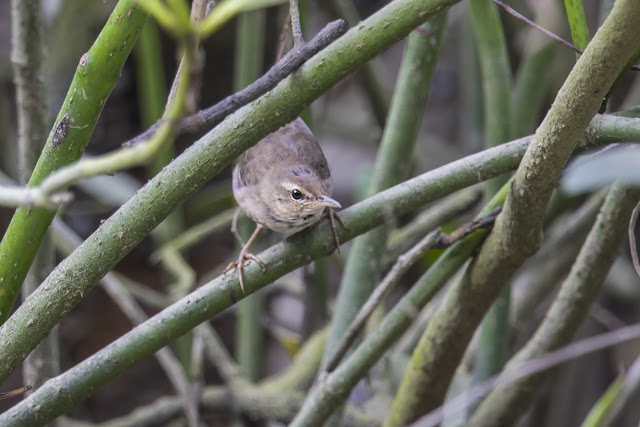Glossy Ibis - a mega rarity in Hong Kong!
A late afternoon report from Whatsapp group about a pair of Glossy Ibis seen at Mai Po on the 20th of March alerted all the birders in Hong Kong. It was stated that the pair only stayed 5 minutes and were not seen since. There are only two previous records of Glossy Ibis in Hong Kong, one in April 1978 and another in May 1994, with a time gap of 16 years in between. 25 years had gone past since the last record, and I do not want to wait another 20 years for the next! So, Kenneth and I set off the next morning hoping to relocate the bird somewhere in Mai Po.
Quite a few other birders also joined in on the search, but everyone came up empty handed. The Ibises were nowhere to be found, even in some very promising habitats! The predicted tide also looked quite promising, so we decided to give up on the Ibis and look for other birds. Out on the mud flats, quite a few Saunder's Gulls were still present, they were all young individuals that are not in a hurry to head back to the breeding grounds.
Saunder's Gull
A flock of large gulls remained fairly far, half of them were gone by the time the tide got to 1.8m. Most of those large gulls were either Heuglin's or Mongolian Gulls. A single Pallas's Gull was also spotted, although it flew off with the main flock and never returned.
Various Larus species with Black-headed Gulls
Pallas's Gull
Both Caspian and Gull-billed Terns were seen, roosting with the other waders on the shallow water. Caspian Terns are especially charismatic and always worth taking a look with their colourful bills.
Caspian Tern
Gull-billed Tern
One great thing about waiting for the tide to come in at the bird hide is that you get to see many birds up close, including the endangered Black-faced Spoonbills. It is especially rewarding during spring when some of them have moulted into their breeding plumage, transforming them into such flamboyant creatures.
Black-faced Spoonbill - breeding plumage
We retreated to the old bird hide as the tide came up even higher. On the boardwalk Fai Jai managed to locate a Styan's Grasshopper Warbler, we heard two in song and managed to grab a record shot of one of them. They are not particularly rare during passage, but being a 'Gropper' you can imagine how secretive they usually are.
Styan's Grasshopper Warbler - a regular but difficult passage migrant
Deep Bay
Retreating to the old hide was a good call, as we were treated with great views of various highly sought after species, including a Far Eastern Curlew, a good count of Great Knots as well as a single Red Knot.
Far Eastern Curlew
Great Knot
Red Knot - only one in amongst the Great Knots
Best bird for me though was no doubt a Long-billed Dowitcher resting fairly close to the bird hide. I've never had much luck with getting a good photo of them, so I was very pleased that this particular one showed so well. Many people get the wrong impression that Dowitchers must be fairly large, this is simply not the case for Long-billed Dowitchers, as they are fairly compact and not that much bigger than a Marsh Sandpiper. Therefore, they never perch with Godwits or Dowitchers in Hong Kong, instead they most often mix in with the Common Redshanks and Marsh Sandpipers.
Long-billed Dowitcher - size comparison with Marsh Sandpiper
I was suppose to help Hoiling with her research work in the afternoon, however half way through I received a text message that the Ibises had been relocated at Long Valley! With Hoiling's approval I rushed back home, got my camera and drove straight to Long Valley. It was most unfortunate that the pair flew away ten minutes before I arrived. Me along with a few others drove around to look for them. We finally struck luck when the pair took to the air and we got a distant flight view. They were later relocated perched on top of a tree, where we were able to get prolonged views of this mega rarity. The pair flew off before I left, was not relocated by other birders until after 6 O'clock.
Glossy Ibis
My dad however got to Long Valley a bit too late and was unable to locate them in the dark! Therefore, I went with him again to Long Valley the next morning, hoping to find them again. The pair proved to be elusive at first, not seen in any of the locations from the previous day. Just as I was getting worried, two dark birds came in out of nowhere and circled around the fields in the air.
Glossy Ibis - pair inflight
The pair landed on the blood worm pond and started feeding, where we were able to get up close to them. Glossy Ibises are well known for their ability to disperse and wander long distances from their breeding colony, being extremely widespread throughout much of Asia, Australasia, Africa, Europe and America. Unlike many species within it's family, Glossy Ibis's population seems to be spreading out. Whereas the population of the Black-headed Ibis in the region is close to extinction, if not already.
Glossy Ibis - feeding on the blood worm pond
For the next hour or so, we just enjoyed brilliant views of the pair wandering various fields around Long Valley. They were very active and gorged themselves on snails and worms. After feeding they flew back to the field they were originally found on the day before and rested. By that time it was 8:15am and my dad and I both left Long Valley a happy birder. This is the second mega rarity we've had in 2018 after the Fire-capped Tit, I am ready for more!
Glossy Ibis - happy ending for everyone!



























































